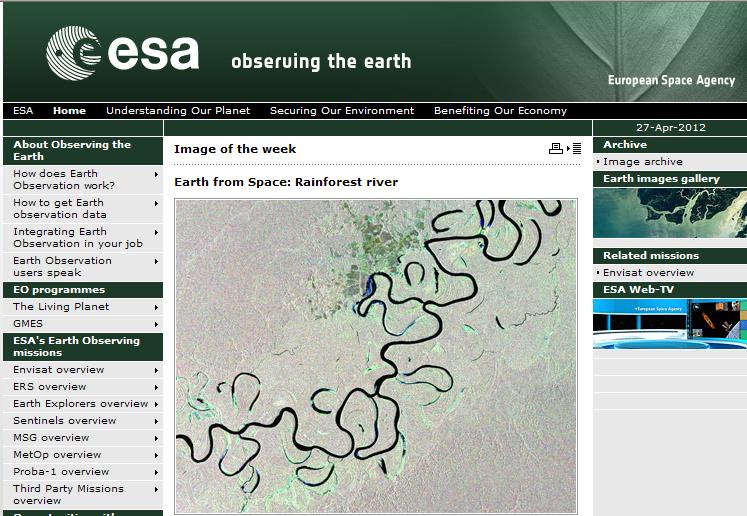A imagem de destaque no “site” da Agência Espacial Europeia (cuja sigla em inglês é ESA) é o Rio Juruá, um dos maiores afluentes do Rio Amazonas. Na imagem postada em destaque na página da agência, o rio parece fazer vários caminhos pela Floresta Amazônica. As imagens foram capturadas em três etapas: 2 de janeiro, 1º de fevereiro e 3 de março de 2012.
De acordo com a ESA, as imagens foram capturadas pelo satélite Envisat. As imagens são individuais e cada uma tem uma cor distinta – vermelho, verde e azul. As imagens foram as últimas feitas pelo satélite que parou de funcionar no último dia 8. O satélite apresentou problemas técnicos e não envia mais imagens. Porém, a missão trabalha para restabelecer o sistema.
O Rio Juruá é um dos maiores afluentes do Rio Amazonas, que flui lentamente entre a floresta, atravessando a Bacia Amazônica – que têm alguns dos maiores rios do mundo. O sensoriamento remoto, segundo especialistas, é uma das maneiras mais eficientes de estudar a região, inclusive para avaliar a extensão e os danos causados pelo desmatamento.
Os estados do Acre e Amazonas são banhados pelo Rio Juruá, que nasce no Peru. Em seguida, o rio atravessa o Acre e deságua no Rio Solimões. É utilizado como hidrovia por várias comunidades da região, que não dispõem de rodovias. Nas margens do Rio Juruá ficam as cidades de Eirunepé, no Amazonas, e Cruzeiro do Sul, no Acre, entre outros.
Renata Giraldi – Repórter da Agência Brasil / Edição: Graça Adjuto – PUBLICADO POR: AGÊNCIA BRASIL – EBC
27 April 2012
This image from the Envisat satellite shows the Juruá River snaking through the Amazon rainforest in western Brazil.
The Juruá is one of the longest tributaries of the Amazon River, flowing slowly through the half-flooded forest country it traverses in the Amazon Basin.
Along the river’s main course are free-standing ‘oxbow lakes’, formed when a river changes course.
Tropical rainforests have some of the largest rivers in the world because of the tremendous amount of precipitation their watersheds receive.
Given its size, remote sensing is the best way to study the Amazon Basin on a large scale – especially for assessing the extent and damage due to deforestation.
This image is a compilation of three images from Envisat’s radar, acquired on 2 January, 1 February and 3 March 2012. The individual images are each assigned a colour – red, green and blue – and when combined, reveal changes in the surface between Envisat’s passes.
Satellite radar data can be exploited to map forest height, 3D forest structure and their natural or anthropogenic disturbance with high spatial resolution and accuracy.
Since forests assist in removing carbon dioxide from the atmosphere, this could prove to be an important tool for assessing carbon stocks and monitoring our planet’s resources.
Envisat has recently been experiencing technical difficulties. Following ten years of service, the satellite stopped sending data to Earth on 8 April. ESA’s mission control is working to re-establish contact with the satellite.
The Image of the Week is featured on ESA Web-TV, broadcast online every Friday at 10:00 CET.
PUBLICADO POR: ESA – Earth from Space: Rainforest river – ESA – Earth from Space: Amazon River




